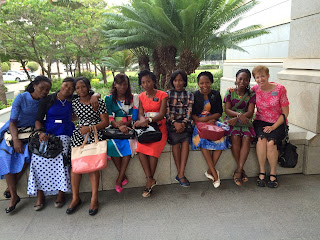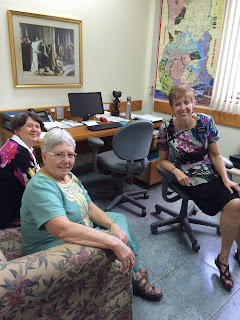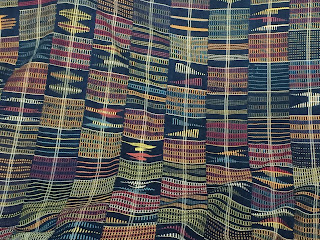On this day, the Paramount Chief of the Agotime Traditional Area and 37 traditional leaders (chiefs) of the towns and villages in the Agotime converge in the city of Kpetoe. An interesting sidelight is, a Caucasian who was a Church employee in Accra, is one of the chiefs. While living in Accra, he became very involved in the Ewe culture in this area and published two photo books on the people of Ghana and the Kente festival that have become standards in Ghana. He was later named a chief with all the powers of the other chiefs. He invited the Senior Missionaries to sit with him, with Elder and Sister Nash immediately beside him.
This is a very colorful day with multitudes of Kente fabric, lots of gold (plated) jewelry, dancing, bands and drumming.
 |
As we drove to the festival site we passed many people
on the side of the road. |
 |
Everyone was happy and excited as they waited
for the festivities to begin. |
 |
Kente costumes of every kind,
for all sizes, |
 |
| Some people watched from their balconies. |
 |
| Elder and Sister Nash made friends with these boys selling Kente. |
 |
Phillipe Kradolfer, also known as
Nene Dunenyo I |
 |
| Elder Nash with other chiefs. |
 |
How do they carry these things on
their heads. |
 |
| Color, color and more color. |
 |
| If you're a chief, you can have someone fan you. |
 |
Don't know the significance of the decoration,
but it's interesting. |
 |
| The staff is very important to the chief. |
 |
| Each one is different. |
 |
| I don't know the significance of the various symbols. |
 |
| I guess a chicken is significant. |
 |
| A queen mother passing by. |
 |
| And another. |
 |
Nene Nuer Keteku III, Principle Chief of
Agotime Traditional Area. |
 |
A procession of women in traditional
dress. |
 |
All ages participate. This may be a
queen in waiting. |
 |
| These women were dancing earlier. |
 |
| This little girl was sitting next to me. |
 |
| Paula and Chief Nene Dunenyo I. |











































































